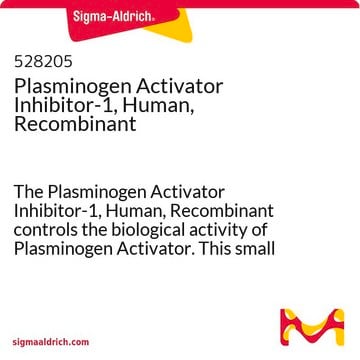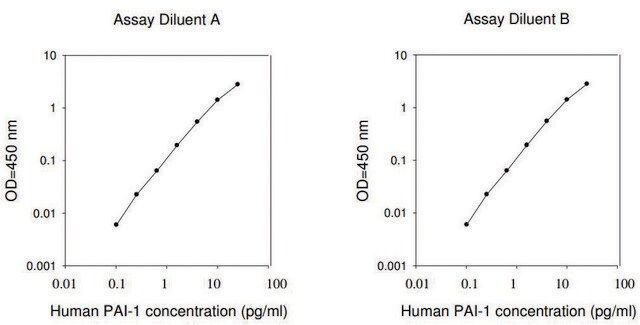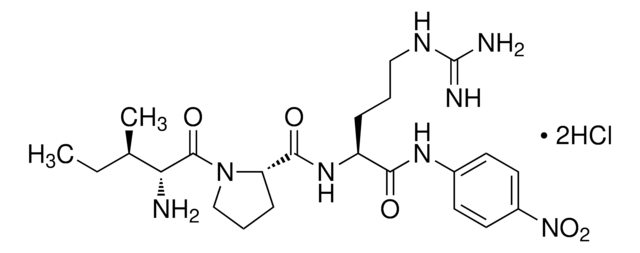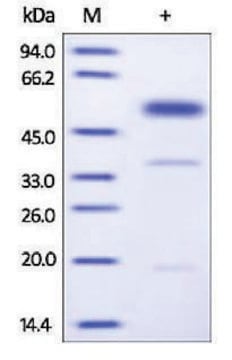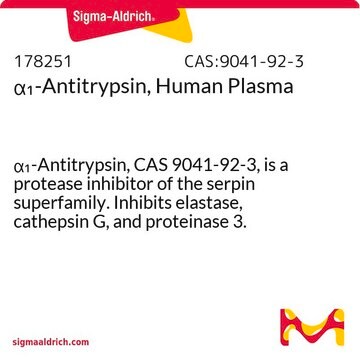The reconstituted product is stable for 1 month at –20 °C and for at least 2 months at –70 °C. Product 528205, a prepared solution, also stored at -70°C, is assigned a retest schedule of every two years. See the link below to review this product page:
https://www.sigmaaldrich.com/US/en/product/mm/528205
A8111
Plasminogen activator inhibitor 1 (PAI-1)
≥200,000 units/mg protein, lyophilized powder, ≥90% (SDS-PAGE)
Sinonimo/i:
PAIE, PLANH1, Plasminogen activator inhibitor, β-migrating endothelial cell-derived type, Serpin E1 PAI-1, Serpine 1
Scegli un formato
CHF 269.00
Scegli un formato
About This Item
CHF 269.00
Prodotti consigliati
Nome del prodotto
Plasminogen activator inhibitor 1 (PAI-1) human, recombinant, expressed in E. coli, ≥90% (SDS-PAGE)
Ricombinante
expressed in E. coli
Livello qualitativo
Saggio
≥90% (SDS-PAGE)
Stato
lyophilized powder
Attività specifica
≥200,000 units/mg protein
PM
~43 kDa
Solubilità
water: 0.1 mL, clear, colorless
N° accesso UniProt
Condizioni di spedizione
dry ice
Temperatura di conservazione
−20°C
Informazioni sul gene
human ... SERPINE1(5054)
Cerchi prodotti simili? Visita Guida al confronto tra prodotti
Descrizione generale
Applicazioni
- as an inhibitor of pro-brain-derived neurotrophic factor (proBDNF) in radioimmunoprecipitation assay (RIPA) in peripheral blood and lymphocytes[3]
- to block plasmin activation in mice infected with C. albicans hyphae[4]
- to test its effect on neurite growth in neurons[5]
Azioni biochim/fisiol
Definizione di unità
Stato fisico
Ricostituzione
Risultati analitici
Codice della classe di stoccaggio
10 - Combustible liquids
Classe di pericolosità dell'acqua (WGK)
WGK 1
Punto d’infiammabilità (°F)
Not applicable
Punto d’infiammabilità (°C)
Not applicable
Scegli una delle versioni più recenti:
Certificati d'analisi (COA)
Non trovi la versione di tuo interesse?
Se hai bisogno di una versione specifica, puoi cercare il certificato tramite il numero di lotto.
Possiedi già questo prodotto?
I documenti relativi ai prodotti acquistati recentemente sono disponibili nell’Archivio dei documenti.
I clienti hanno visto anche
Articoli
Lipid Induced Insulin Resistance
-
Once it has been reconstituted, what is the recommended storage temperature? Will the reconstituted liquid be stable at 4 C for short-term storage (e.g. <24 hrs)?
1 answer-
Helpful?
-
Active Filters
Il team dei nostri ricercatori vanta grande esperienza in tutte le aree della ricerca quali Life Science, scienza dei materiali, sintesi chimica, cromatografia, discipline analitiche, ecc..
Contatta l'Assistenza Tecnica.


